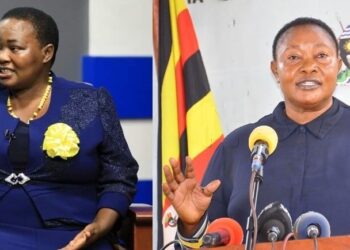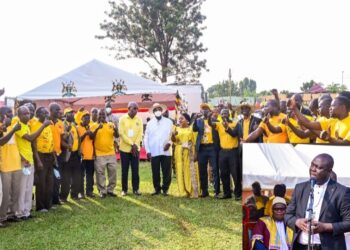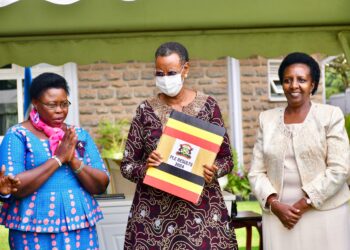Uganda, a country known for its rich cultural heritage and diverse landscapes, has set ambitious goals for itself. Among these has been the aspiration to achieve middle-income status by the year 2040.However according to President Museveni and world bank, Uganda has achieved middle income status after making significant improvements in the human development index (HDI) rising from a global ranking of 166 in 2022 to159 in 2024.Additionally Uganda meets the world bank’s income threshold of US$1,046 per Capita for the 2021-2022 FY and the per Capita daily consumption expenditure is between$2-$20 in purchasing power parity (PPP) terms.
To realize this vision by 2040, it is imperative that the National Resistance Movement (NRM) focuses on promoting rural development. This according to the NRM’S manifesto of 2021-2026 that has a theme of “Securing Uganda’s Future”. It focuses on how it is going to continue with it’s strategic mission of addressing the plight of the 68%households in subsistence in a comprehensive collective and sustainable way.
However a lot needs to be done if all this is to be achieved by 2026.Rural areas in Uganda are home to a significant portion of the population and can play a crucial role in the country’s economy if government empowers them to increase production.Forinstance according to the performance of economy report in January 2024 by MOFPED,Uganda imported merchandise worth USD886.24M and exported merchandise USD615.05M in November 2023 indicating a trade deficit.Therefore if rural development can be heavily invested in by NRM government, it would help us to increase our revenues through exporting various products and this would enable us to reduce our public debt that stands at $24.7billion which has been eating up a growing share of revenues and hitting other spending priorities like education,health etc. of .By prioritizing rural development, the NRM can pave the way for sustainable economic growth, poverty reduction, and ultimately, the attainment of a modern and prosperous nation that is free from external debts which stands at 60% now.
Rural development is key to driving overall economic growth and reducing poverty in Uganda. The majority of Uganda’s population resides in rural areas, where agriculture is the primary source of livelihood.
By investing in rural infrastructure, agricultural productivity, and access to essential services such as healthcare and education, the NRM can uplift rural communities and create opportunities for economic advancement. Moreover, a vibrant rural economy can stimulate overall economic growth by increasing agricultural output, creating employment opportunities, boosting rural incomes and even increasing our export revenues from processed agricultural products.
Therefore the NRM is ought to push Operation Wealth Creation (OWC) whose mandate is to distribute farm inputs to farmers coordinate govt ministries , departments and agencies for improved service delivery aimed at transforming the 68% ugandans outside the money economy But the question is, has it lived to it’s expectations? Who is there to check their progress? For instance from 2021-2026 they’re supposed to distribute in the second phase livestock/stocking materials;1,782 heifers,8,186 pigs,29,950 broilers, 6,000 layers,59,950 kroilers , 3,960,400 fingerlings.
So NRM needs to check this out if it has been achieved and if it’s true success stories ought to be documented to inspire other rural people to engage in commercial agriculture.
Despite their significant contribution to the economy, rural communities in Uganda face numerous challenges that hinder their development. Poor infrastructure, limited access to markets, inadequate healthcare ,problems of post -harvest handling and storage, education facilities, and climate change are some of the key obstacles that rural residents grapple with on a daily basis. Addressing these challenges requires a holistic approach that combines policy interventions, investments in infrastructure, and community participation.
For example many community grain stores need to be constructed in districts that grow cereals in bulk, provision of Maize & rice milling equipment to farmers groups in several districts that plat these cash crops. Additionally, the dairy farmers need to be supported with sets of milk coolers and matching generators through their organizations in different groups. For the issue of markets I am happy that PACEID under the auspices of Odrek Rwabwogo are doing a tremendous work in marketing our agricultural products abroad.
Important to note is a fact that as the ruling party in Uganda, the NRM plays a pivotal role in shaping the country’s development agenda. That is;
To promote rural development effectively, the NRM must prioritize investments in key areas such as agriculture, infrastructure, healthcare, and education. By implementing pro-poor policies, providing support to smallholder farmers, improving access to markets, and enhancing rural services, the NRM can empower rural communities to thrive and contribute meaningfully to the country’s economic growth.
Therefore in order to accelerate rural development and progress, the NRM should consider the following policy recommendations:
Invest in agricultural modernization and mechanization to increase productivity and enhance food security. for instance the distribution of 320 tractors and matching implements to farmers’ groups in 123 districts should be followed with MAAIF. NRM needs to find out if the bush clearing unit under MAAIF was set up and if yes can it be easily accessed by farmers at reasonable terms?
* Improve rural infrastructure, including roads, electricity, and water supply, to facilitate market access and economic growth. Therefore NRM needs to intensify the follow-up on the implementing ministries and agencies. For example according to our 2021-2026 manifesto there is supposed to be construction of 500 private valley tanks and 120 communal valley tanks for livestock watering in the cattle corridor districts with affirmative action offered to particular areas. How far have we gone? Have the 617 acres of irrigation in 49 districts been added? Etc
* Strengthen healthcare and education services in rural areas to improve the well-being and human capital of rural residents.Health centers should be stalked with medicines at all times because a healthy population becomes productive.
* Promote sustainable land and natural resource management practices to mitigate the impact of climate change and protect the environment.This atleast the president is trying his level best with environment protection campaigns and NEMA is also doing well at this through the indefatigable Dr Akankwatsa Barirega.
* Enhance access to financial services and credit for smallholder farmers and rural entrepreneurs to stimulate entrepreneurship and economic growth.The NRM government should ensure it empowers cooperatives again as well as making it easy for people in villages to access cheap credit or increasing the funding of PDM and other programs like Emyooga.
In conclusion, promoting rural development is essential for Uganda to become prosperous and ensure inclusive growth for all its citizens. By prioritizing investments in rural infrastructure, agriculture, healthcare, and education, the NRM can create an enabling environment for rural communities to thrive and contribute to the country’s economic development. Therefore since the mantle of securing the future of the nations is so great a task for one to play bets and 58.64% Ugandan voters (6,042,898) entrusted NRM as the political party to take the pearl of Africa forward, It is imperative that the NRM adopts a comprehensive approach to rural development that addresses the unique needs and challenges of rural areas. With strategic planning, effective policies, zero tolerance towards corruption and targeted investments, Uganda can unlock the full potential of its rural communities and pave the way for a prosperous and sustainable future.
The writer is a Rural Development Specialist.
Do you have a story in your community or an opinion to share with us: Email us at editorial@watchdoguganda.com













